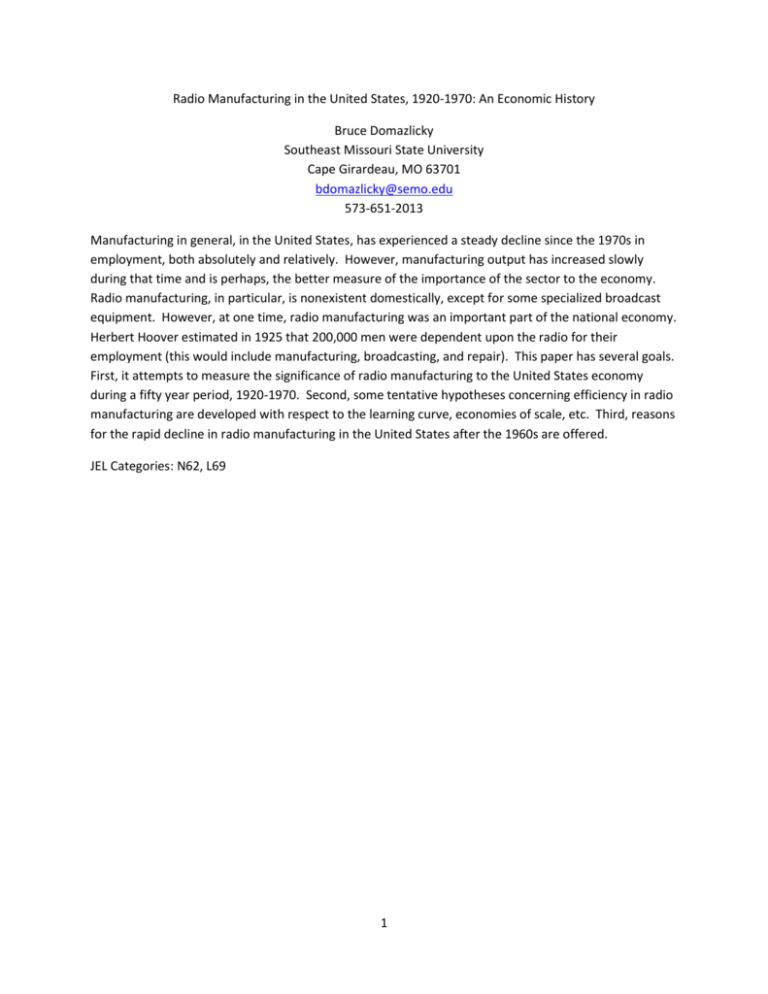Missouri Valley Economics Association Paper
advertisement

Radio Manufacturing in the United States, 1920-1970: An Economic History Bruce Domazlicky Southeast Missouri State University Cape Girardeau, MO 63701 bdomazlicky@semo.edu 573-651-2013 Manufacturing in general, in the United States, has experienced a steady decline since the 1970s in employment, both absolutely and relatively. However, manufacturing output has increased slowly during that time and is perhaps, the better measure of the importance of the sector to the economy. Radio manufacturing, in particular, is nonexistent domestically, except for some specialized broadcast equipment. However, at one time, radio manufacturing was an important part of the national economy. Herbert Hoover estimated in 1925 that 200,000 men were dependent upon the radio for their employment (this would include manufacturing, broadcasting, and repair). This paper has several goals. First, it attempts to measure the significance of radio manufacturing to the United States economy during a fifty year period, 1920-1970. Second, some tentative hypotheses concerning efficiency in radio manufacturing are developed with respect to the learning curve, economies of scale, etc. Third, reasons for the rapid decline in radio manufacturing in the United States after the 1960s are offered. JEL Categories: N62, L69 1 I. Introduction If one were to purchase a personal radio in the United States today for use in the home, it is a guarantee that it will not say “Made in America” on it. Personal radios sold today in the United States are primarily manufactured in Southeast Asia, though a few still come from Western Europe, primarily Germany. The closest to radio manufacturing that still exists in the United States today consists of NAICS code 334220, Radio and TV Broadcasting and Wireless Communications Equipment Manufacturing. This industry employed 73,140 workers in 2010 (0.7% of all manufacturing employment) with a value added of $18.1 billion (0.8% of all manufacturing value added). There is also NAICS codes 334310, Audio and Video Equipment Manufacturing, which includes the production of personal radio and TV sets, but the sector only employed 6,860 workers in 2010 and was not producing any radio or TV sets. Given the near nonexistence of radio manufacturing in the U.S. today, it might be surprising to learn that radio manufacturing, including the export of radios, was once an important domestic industry. Herbert Hoover remarked in 1925 that 200,000 men were dependent on the radio industry for their livelihood. As late as 1947, there were 178,595 employees involved in manufacturing radios in 857 establishments. Total production in 1947 amounted to nearly 17.5 million units (mostly AM and portable radios). After 1947, radio manufacturing in the United States steadily declined due to saturation, competition from television and foreign competition. By 1954, domestic production was already only 50% of what it had been in the late 1940s. In addition to radio manufacturing, there was a substantial industry in radio repairs. Radios were a relatively expensive product in the 1930s and 1940s, with average prices that approached the weekly wages of those producing them. Therefore, a cottage industry quickly arose in radio repair. By 1939, there were 10,732 establishments repairing radios with 11,000 proprietors and an additional 2,591 employees. It is evident that most of these repair shops were very small (one-person operations) with total receipts of $21.7 million or about $2,025 per shop. This paper will first outline a history of the development and the decline of radio manufacturing in the United States from earliest times in the 1920s to about 1970, when radio manufacturing had declined to insignificance. As part of this history, market structure in manufacturing as well as efficiency and productivity will be addressed. In the latter part of this period (basically the mid 1950s forward), radio manufacturing declined rapidly; some reasons for this decline will be offered. 2 II. Radio Manufacturing in the United States: An Economic History Radio manufacturing in the United States took hold in the 1920s and grew rapidly. As Table 1 shows, the volume of production of radio sets and tubes increased almost 40 times in the decade of the 1920s. By the middle of the decade, Herbert Hoover claimed that 200,000 men owed their employment to the radio (this, of course, would include manufacturing, sales, repair and the broadcasting industry). [Jome, 1971] This may be a bit of an overstatement, but it is clear that the new industry by the end of the decade was already well established in the nation. As an interesting side note, in 1927, the average worker in radio manufacturing put in a 48.5 hour work week. Males earned 59 cents per hour while females were paid 38.4 cents per hour. Table 1. Value of Radio and Tube Production, 1921-1929 YEAR Value of Production (000s) Index, 1921=100 1921 $10,648 100.00 1923 $29,679 278.73 1925 $147,538 1,385.59 1927 $149,658 1,405.50 1929 $411,637 3,865.86 Source: Statistical Abstract of the United States U.S. exports of radio sets and tubes were already making an important contribution to the country’s balance of trade by 1926. Table 2 shows the quantity and value of radio sets exported in the last half of the decade of the 1920s as well as the average price. One item that stands out from the table is that the average price of an exported radio was in the $40 to $50 range, a rather high price at the time. For comparison, the average male worker in radio production earned 59 cents an hour in 1927. (Females earned 38.4 cents per hour; apparently, gender wage discrimination was more acceptable then.) This implies that to buy a $45 radio set would mean the average male production worker would have to work about 76 hours or about a week and a half (the average production worker spent 48 hours a week on the job). Vacuum tubes were a big part of radios and needed to be changed often so that the export of tubes was also an important contributor to the nation’s balance of payments as shown in Table 3. 3 Table 2. Exports of Radio Sets during the 1920s YEAR Number of Sets Value of Exports (000s) Average Price 1926 69,482 $2,874 $40.97 1927 75,839 $2,961 $39.04 1928 96,341 $4,550 $47.23 1929 200,936 $9,776 $48.65 1930 245,192 $11,550 $47.10 Source: Statistical Abstract of the United States Table 3. Exports of Vacuum Tubes during the 1920s YEAR Number of Tubes (000s) Value of Exports (000s) Average Price 1926 665 $868 $1.31 1927 722 $1,004 $1.39 1928 558 $1,018 $1.82 1929 1,233 $1,997 $1.62 1930 1,774 $2,363 $1.33 Source: Statistical Abstract of the United States In the 1930s, radios came to be more standardized in terms of their technology. With the introduction of the super heterodyne set, “…the radio receiver reached practically the form it retains to this day, and progress during the 1930’s and subsequently, was mainly a matter of detail.” [Sturmey, p. 178] The basic AM radio used what is sometimes referred to as five-tube technology, which exhibited little change for at least three decades. The major innovation over time was miniaturization as tubes became smaller, allowing for smaller radios. (See Diagram 1.) Short wave radios, which were popular in the 1930s and later, as well as radios that included FM, which came much later, required more complicated circuitry, but these involved minor extensions of existing technology. 4 Diagram 1. Radio Tubes from the 1930s, 1940s and 1950s. Despite the Great Depression, radio manufacturing remained an important sector in the national economy. It, of course, experienced significant variability during the 1930s as evidenced by Table 4, which presents details on wage earners and production value for selected years in the 1930s. The effects of the Great Depression in the early part of the decade and then the recession of 1938 are apparent from the data. Table 5. Production of Radios, Tubes and Phonographs in the 1930s YEAR Establishments Wage Earners Wages (000s) Production Value (000s) 1931 217 36,490 $35,146 $193,143 1933 156 32,879 $29,655 $121,802 1935 196 44,796 $42,906 $200,973 1937 162 48,343 $52,002 $277,807 1939 224 43,508 $47,026 $275,870 Source: Statistical Abstract of the United States 5 Table 5 includes the production of phonographs as well, but the bulk of the production is in radios and tubes. It should also be noted that annual earnings of production workers range from about $900 in 1933 to close to $1,100 in 1939. Exports of radios also continued to grow in the 1930s. During the decade, exports averaged 528,600 sets per year with an average annual value of $12.5 million. This translates into an average price of an exported radio of $23.75 (about $438 in today’s dollars). The market structure in radio manufacturing during the 1930s and beyond is probably best characterized by monopolistic competition. Entry was relatively easy as RCA (Radio Corporation of America) freely licensed its numerous patents to any firm willing to pay the price. Many firms were what Sturmey calls assemblers; that is, they bought the necessary components (tubes, capacitors, resistors, etc,) from the major suppliers, designed their own housing and then assembled the parts into a finished product. The smallest of the assemblers might be best labeled “garage” type producers who put out a limited number of sets and only a few different designs. It is estimated that over the period of radio manufacturing in the U.S., there were 3,205 different brand names producing 75,480 models (Radio Museum). Information from the 1947 Census of Manufactures indicates that the four-firm concentration ratio was 25.6 and the top 20 firms had 54.4% of the market. So the market was one of several large producers with many smaller ones. Competition tended to be on the design of the product since all used the same technology. “Each year the advertising and sales departments wanted something new to talk about and each year the engineers obliged…the engineer was too often at the mercy of the whims and profit considerations of the management and the opinionated instructions of the sales department. So long as the public was willing to buy the goods thus devised and manufactured, there was no great urgency and little encouragement for radical technical innovations.” [MacLaurin, pp. 140141] In the long run, firms operating under conditions of monopolistic competition can be expected to earn normal profits. This appears to have been the case with respect to radio manufacturing. “As more and more firms were drawn into the industry, profit margins were reduced; and by the end of the 1920’s they had largely disappeared for many companies.” [MacLaurin, p. 262] The competitive conditions in radio manufacturing meant that the incentive and the ability to undertake research were limited to a few large firms. “Between 1920 and 1940, outside of the larger patent holding companies-RCA, GE, Westinghouse and the Telephone company-conditions were so competitive in the radio manufacturing industry that most firms found it difficult to undertake research. The RCA licensees were primarily concerned with achieving volume production, lowering costs and 6 obtaining brand preference for their radios through advertising and promotion.” [MacLaurin, p. 251] What research that did take place during this time was directed toward improvement of the existing product as opposed to the creation of new products. [MacLaurin, p. 252] Patent cross-licensing was also an important feature of the radio manufacturing sector. Political pressure in the 1920s forced RCA to freely cross-license its patents to all manufacturers so that by 1928 an RCA license was necessary for any firm embarking upon the manufacture of radios. But what this meant is that new firms would be unable to develop their own patent positions and, therefore, they had little incentive to devote resources to research and development. (MacLaurin) The bigger producers such as Zenith, Crosley, RCA, Emerson, etc. were able to develop line production methods where the empty chassis starts at one end and the various components are put in place as it passes along on a conveyor belt. Sturmey, speaking of Great Britain remarks, “The adoption of mass production methods in the 1930’s made the possession of capital a vital attribute for success in the industry and entry more difficult.” [Sturmey, p. 173] While this is likely the case, it must be emphasized that even with assembly line techniques, the production of a radio was very labor intensive. Wires had to be cut to the correct lengths, something that could be done by machine, but the wires and other components had to be put in place and soldiered by hand. This limited the advantages to being larger and meant that economies of scale were not likely to be very extensive in the industry. Diagram 2 is a picture of the underside of a 5-tube technology radio from the 1940s. All the connections and soldiering as mentioned, had to completed by a worker using very little capital. In addition, the learning curve was not very steep. Most of the operations involved were fairly simple and routine so that workers, after a few days on the job, probably were as efficient as they were going to get. 7 Diagram 2. Five-Tube Technology It is difficult to get a read on the efficiency of production and improving productivity in manufacturing, given the data that are available. Hints on efficiency and production methods are found in various sources, but are very general in analysis. (See, e.g., Frankel, 1955) It is possible to estimate production value per worker from the data, but of course, the items being produced changed over time to an extent, though technology remained fairly constant. Table 6 gives an estimate of production value per worker for selected years in the 1930s. The numbers are adjusted using the implicit price deflator (1958 = 100). The values in Table 6 give the suggestion that labor productivity increased modestly during the 1930s. Note that the price index changed very little during the 1930s so that increases in the value of production per worker are likely to reflect increases in output. 8 Table 6. Production Value per Worker, 1930s YEAR Production Value per Worker 1931 $11,815 1933 9,427 1935 10,530 1937 12,915 1939 14,154 As to be expected, radio manufacturing shifted heavily towards the production of radios for the military after 1941. Details on the production of personal sets for consumer use versus radio sets for the military are not available. However, we can get an idea of the switchover by looking at excise taxes on radios during the war period. In Table 7 we see that excise tax collections by the Federal Government declined by about 75% in 1943 through 1945. Such tax collections then increased quickly once the war ended and the production of sets for consumer use resumed to prewar levels. The Federal excise tax on radios was first implemented in 1933 (the trough of the Great Depression!) at 5% of the value of the radio or phonograph. The Revenue Act of 1941 increased the rate to 10%, which accounts for the significant increase in revenues in 1942. The excise tax was eliminated on radios, phonographs and televisions in 1966. (United States Treasury) The huge jump in excise tax collections in 1947 and beyond is due to the inclusion of televisions in the numbers. Television production, of course, grew rapidly after the war, adding to the revenue collection of the Federal government. 9 Table 7. Excise Tax Receipts from Radios and Phonographs Year Receipts (1000s of dollars) 1933 $2,207 1934 3,157 1935 3,625 1936 5,075 1937 6,754 1938 5,849 1939 4,834 1940 6,080 1941 6,935 1942 19,144 1943 5,561 1944 3,402 1945 4,753 1946 13,385 1947 63,856 1948 67,267 1949 49,160 Radio manufacturing after World War II peaked in 1947 as many firms entered and quickly exited the industry. Major firms such as Zenith, Crosley, Philco and Emerson continued to be important producers and employers. Table 8 is an index of radio production from 1947 to 1955, which exhibits a steady decline except for a jump in the final year. Alongside is an index of television production by comparison. One factor that gave a modest boost to radio production after the war was the manufacture of radios for automobiles, which remained strong even after the production of home sets leveled off. 10 Table 8. Indexes of Radio and Television Output (1947-49 = 100) Year Radios Televisions 1947 133 13 1948 99 70 1949 68 217 1950 77 561 1951 64 396 1952 53 436 1953 67 541 1954 52 522 1955 77 578 Radio manufacturing in the United States faced three main headwinds in the 1950s that led to its rapid decline. One factor in the decline was simple saturation. By the 1950s, over 96% of homes had at least one radio. As a mature industry, the room for further growth was limited. A second factor as seen in Table 8 was competition from television. As people fell in love with the new medium, the days of the family huddling around the console radio in the living room were coming to an end. Radio programming changed with the times as the medium’s former stars switched to television, leaving radio to concentrate more on news and music. The third factor that led to the decline of radio manufacturing was changing technology that enabled foreign competition to get a toehold in the U.S. market. A major change was, of course, the development of the transistor in 1947 by Bell Labs, which could be used to replace all of the tubes. However, even with this breakthrough, many, if not most radios, were still using tubes well into the 1960s. Clearly, it took time for this new technology to be adopted. However, in terms of the manufacturing process, the use of the printed circuit was probably more important in reducing production costs and leading to greater foreign competition. The use of the printed circuit greatly lowered labor costs by reducing the need to place and connect wires, and less soldiering was also required. Diagram 3 shows an older radio next to a later one that used a printed circuit. While the latter radio still is using tubes (it is from the late 1950s), its assembly would be much easier and less expensive due to the printed circuit. The labor skill to complete a radio with a printed circuit would be substantially less than one that required all of the wires to be inserted and connected in just the right 11 places. Therefore, relatively lower skilled workers who were in abundance in Southeast Asia in the 1950s and 1960s could produce a product that was very price competitive. Diagram 3. Comparison of Printed Circuitry with Earlier Designs The subsequent decline in radio manufacturing in the 1950s and 1960s is evident from Table 9. By 1972, only 100,000 AM radios were being produced in the United States. Similar reductions in other categories of radios also occurred. The only exception consisted of radios for automobiles. Partly due to the captive nature of automobile radios, the manufacturer could require the customer to purchase its radio if s/he wanted to purchase the automobile, reducing the price sensitivity of the purchaser. In 12 addition, a radio would add maybe $90-$100 to the purchase price of a $2,000 - $3,000 automobile, an amount that was unlikely to deter consumers. Average manufacturers’ prices for different categories of radios are given in Table 10. The top half gives prices in current dollars, while the bottom half are prices in constant dollars, using the Consumer Price Index (1982-84 = 100) as the benchmark. Notice that the average weekly wage in all manufacturing is given in the constant dollar table of prices. Whereas in the 1930s, a typical worker in manufacturing may have to work almost a week and a half just to buy a simple AM radio, by 1967, the worker could purchase an AM radio for less than 4 hours of work. Table 9. Radio Production After World War II (Thousands of Units) Type of Radio 1954 1958 1967 1972 AM 2,842 2,336 1,300 100 AM-FM 124 251 1,100 300 Clock 1,862 2,076 4,000 900 Portable 1,569 3,332 3,000 800 Automobile 4,306 3,935 8,200 11,200 Source: Census of Manufacturing Table 10. Average Manufacturers’ Prices, Current and Constant Prices Type of Radio 1947 1954 1958 1967 AM $16.37 $14.56 $13.28 $10.00 AM-FM 44.44 33.54 34.19 27.10 Clock NA 20.10 18.28 16.45 Portable 21.77 NA 24.71 14.20 Automobile 29.92 25.87 25.86 25.74 $48.90 $71.64 $83.50 $114.90 Weekly WageManufacturing 13 Table 9, Continued, Constant Dollars (1982-84 = 100) Type of Radio 1947 1954 1958 1967 AM $73.31 $54.13 $45.95 $29.94 AM-FM 199.01 124.68 118.30 81.14 Clock NA 74.72 63.25 49.25 Portable 97.48 NA 85.50 42.51 Automobile 134.00 96.17 89.48 77.07 Source: Computed from Data in the Census of Manufacturing The last tube-powered portable radio manufactured in the United States was by Zenith Corporation in 1962. In 1982, Zenith marketed its last radio. [Bucher] While I do not have any reference yet, it appears that Zenith manufactured its last tube radio of any kind around 1967. Zenith did produce some transistor radios domestically for a time after 1966, specifically its popular TransOceanic Radio; however, most transistor radios after the 1960s were produced in Southeast Asia. Other major manufacturers were out of the market much earlier, though some held on for awhile. Philco, for example, was acquired by Ford Motor Co. in 1961 and mainly produced radios for Ford vehicles. Motorola sold its radio and TV manufacturing division to Matsushita in 1974. Hallicrafters was sold to Northrup Corporation in 1966, but even by then, competition from Asian producers had pretty much ended domestic production of radios. III. Summary and Conclusions Radio manufacturing was once a vital part of the manufacturing sector in the United States. Nearly 206,300 individuals were employed in the manufacture of radios and tubes 1947. By the end of the 1960s, very few individuals in the United States were employed in the manufacture of radios. A combination of saturation, competition from television and overseas competition led to the demise of the domestic industry. During the heyday of the industry, it could be best characterized as monopolistic competition. Product differentiation was the main method of competition as opposed to price. While some companies might boast of the superiority of their products, in the end, the technology used was basically the same and the performance of individual radios was quite similar. 14 It is interesting to compare the development of the radio industry in the United States with that of the personal computer. While the technology of the radio remained constant for most of the period covered in this paper, the personal computer has been marked by constantly improving technology. This has led to computers with generic designs as consumers select their models based on the computing power that they afford. Also, given changing technology, the consumer expectations are such that the current PC will be replaced by a new one in a few years at most. By way of contrast, radios were relatively expensive items well into the 1950s and so were not bought with the idea that they would soon be replaced. Hence, features emphasizing style would be important to consumers. While PC manufacturing still exists in the U.S., much has rapidly moved overseas, again mostly to Southeast Asia, similar to radio manufacturing. Given the experience of the domestic radio manufacturing industry, it seems likely that most PC manufacturing, except for specialty equipment and peripherals, will also eventually move overseas. 15 References Bucher, E.E. “The Radio Industry,” in The Development of American Industries, J.G. Glenn and W.B. Connell, eds., New York: Prentice-Hall, 1941. Frankel, M. “American Productivity Differences: Their Magnitude and Some Causes,” American Economic Review, May, 1955, volume 45(2), 94-112. Jome, H.L. Economics of the Radio Industry, N.Y.: Arno Press, 1971 (Reprint of 1925 edition published by A.W. Shaw & Co.) MacLaurin, W.R. Invention and Innovation in the Radio Industry, N.Y.: MacMillan Co., 1949 _____________ “Patents and Technical Progress-A Study of Television,” Journal of Political Economy, April, 1950, vol. 58(2), 142-57. Radio Museum, http://www.radiomuseum.org/cy/cym-num.html Scott, C.E. “The History of the Radio industry in the United States to 1940,” EH.Net.Encyclopedia, edited by Robert Whaples, March 26, 2008 http://eh.net/encyclopedia/article/scott.radio.industry.history Sturmey, S.G. The Economic Development of Radio, London: Duckworth, 1958. Watkins, T. :The Economic History of the Radio Industry,” http://www.sjsu.edu/faculty/watkins/radio.htm U.S. Bureau of the Census, Annual Survey of Manufacturing, various years U.S. Bureau of the Census, Economic Census of Manufacturing, various years U.S. Department of Commerce, Statistical Abstract of the United States, various years U.S. Treasury, Annual Report, various years 16







